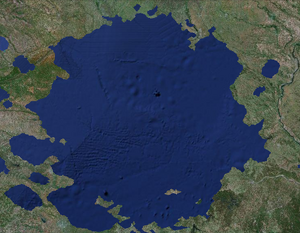| Luna | |

| |
| Designations | |
| Pronunciation | /ˈluːnə/ |
| Adjective | Lunar, Selenic, Selenitive |
| Physical characteristics | |
| Mean radius | 1,737.10 km (0.273 Earths) |
| Equatorial surface gravity | 3.24400 m/s2 (0.330 8 g) |
| Axial tilt | 1.5424° (to ecliptic) |
Luna is Earth's only natural satellite and the fifth-largest satellite in the Solar System. It is one-quarter of Earth's diameter and 1⁄81 its mass. It has similar features to Earth itself, such as water, land, animals and even intelligent life forms, the lunans. Luna is sometimes referred to as the Moon, the Green Planet and Selenica.
Etymology[]
"Luna" in different languages[]
| Language | Name | Transliteration |
|---|---|---|
| Belarusian | Месяц | Miesiac |
| Croatian | Mjesec | |
| Classical Chinese | 月 | |
| Chinese | 卢纳 or 月亮 | Luna or The Moon |
| English | Luna or The Moon | |
| French | La lune | |
| German | Der Mond | |
| Greek | Η Σελήνη | I Selíni |
| Greenlandic | Qaammat | |
| Georgian | მთვარე | mt’vare |
| Hungarian | Hold | |
| Hindi | चन्द्रमा | Candramā |
| Icelandic | Tunglið | |
| Indonesian | Bulan | |
| Inuktitut | ᑕᖅᑭᖅ | Taqqiq |
| Italian | La Luna | |
| Japanese | ムーン | Mun |
| Danish, Norwegian, Swedish | Månen | |
| Finnish, Estonian | Kuu | |
| Kannada | చంద్రుడు | Candruḍu |
| Korean | 달 | Dal |
| Latin | Lunae | |
| Lativan | Mēness | |
| Lithuanian | Mėnulis | |
| Macedonian | Месечината | Mesečinata |
| Mongolian | Сар | |
| Portuguese | Lua | |
| Russian, Bulgarian | Луна | Luna |
| Romanian | Lună | |
| Serbian | Месец | Mesec |
| Slovak | Mesiac | |
| Spanish | La Luna | |
| Tatar | Ай | |
| Tamil | நிலா | Nilā |
| Thai | ดวงจันทร์ | Dwng cạnthr̒ |
| Turkish | Ay'ın | |
| Talnuwathiki | Talnuwathi | |
| Ukrainian | Місяць | Misyatsʹ |
| Vietnamese | Mặt trăng | |
| Welsh | Lleuad |
Habitability[]
A planet that can sustain life is known as habitable, even if life did not originate there. Luna, along with Earth, are the only two known celestial bodies that provide the (currently understood) conditions of liquid water, an environment where complex organic molecules can assemble, and sufficient energy to sustain metabolism. The distance of Luna from the Sun, as well as its orbital eccentricity, rate of rotation, axial tilt, geological history, sustaining atmosphere and protective magnetic field all contribute to the conditions believed necessary to originate and sustain life on this planet.
Biosphere[]
Natural resources and land use[]
Luna is a Pangaea-like moon, comprised of one major continent with smaller islands surrounding it. Most of Luna is comprised of land, (unlike Earth which is mostly comprised of water) which is why many humans consider Luna "the Green Planet."
Geography[]
Near side of Luna[]
Far side of Luna[]

The Aitken Basin during the warm 14 Lunar days when the far side of Luna faces the sun.

Details of the Earth-Lunar system. (Photos and data from NASA.)

A scale representation of the relative sizes of, and average distance between, Earth and Luna (click to enlarge).
| |||||||||||||||||||

















